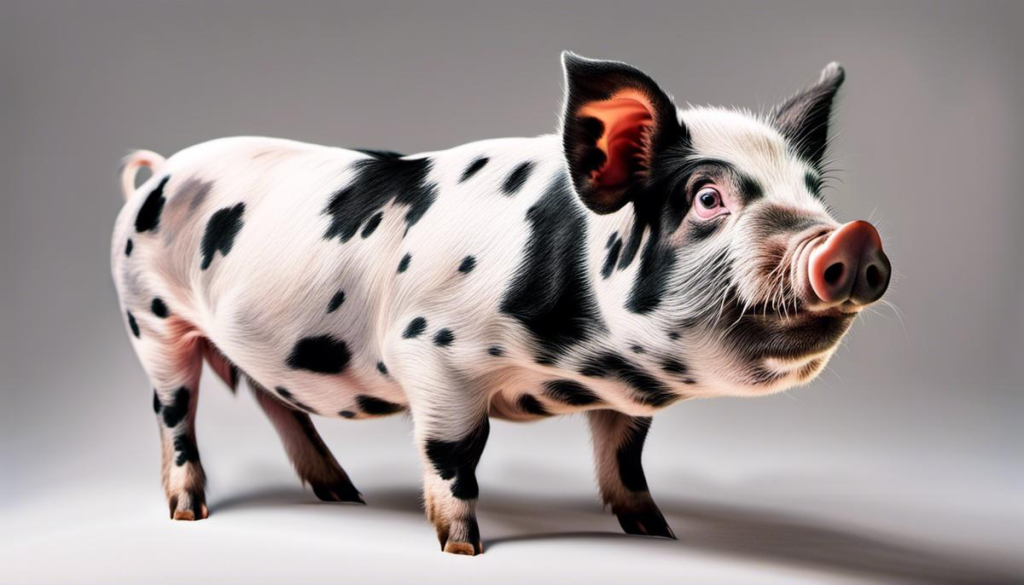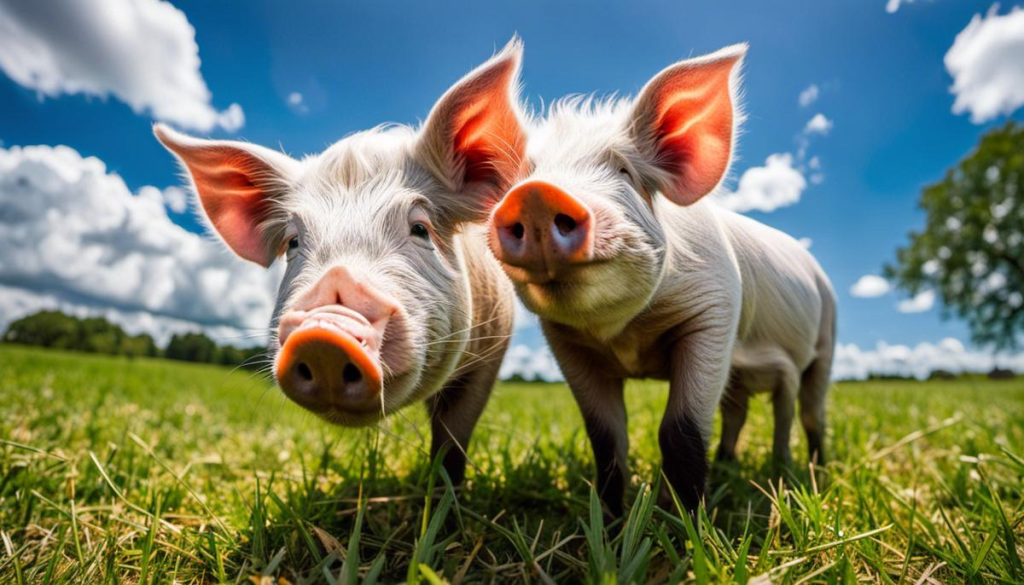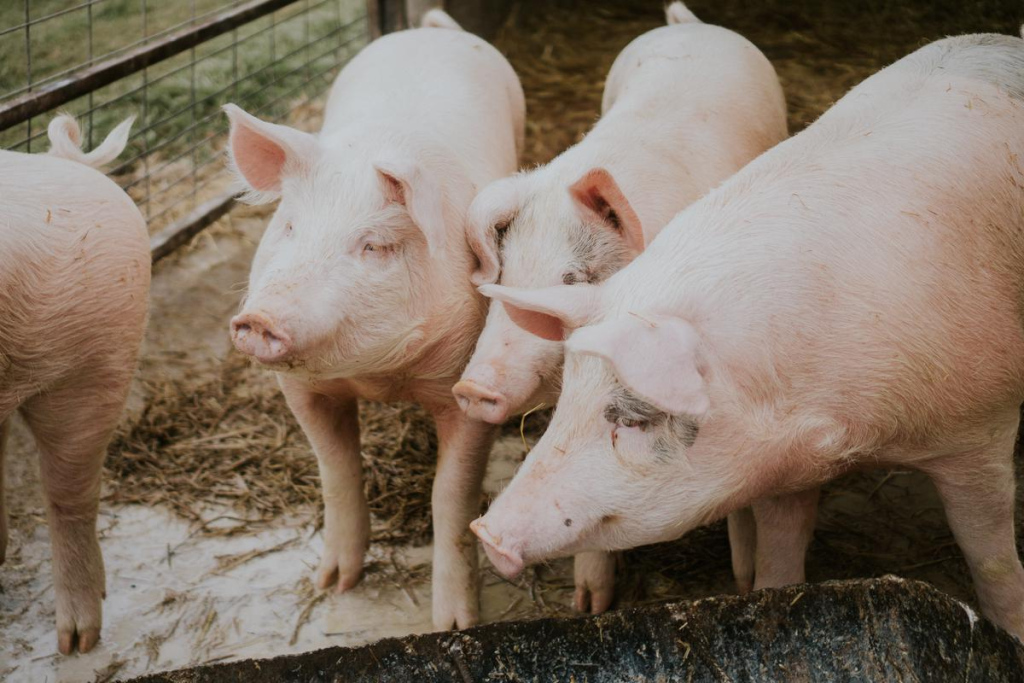In the intriguing world of pig breeds, few are as distinctive as the Spot pig. Known for their characteristic spotted skin, these pigs carry a unique history rooted in the diverse agricultural heritage of numerous continents. Since their genesis, they have evolved from a simple pig breed to an animal of notable agricultural importance, revered for its meat production capabilities. This exploration into the origin and early history of Spot pigs reveals how various breeds were crossbred to create this distinctive pig breed, providing an insight into the geographical areas they hailed from and how they were initially deployed. Furthermore, a deeper look into the physical characteristics of Spot pigs goes beyond their overtly spotted appearance to size, weight, and other distinguishing physical features. The temperament of Spot pigs, crucial in their interaction with humans and their social behaviors among their own breed, is another riveting aspect this study underscores. Finally, a detailed examination of the role of Spot pigs in agricultural meat production, their conservation status, and the accompanying challenges provides a comprehensive understanding of this fascinating breed.

Origin and Early History of Spot Pigs
Origins of the Spot Pig Breed
The Spot pig, also commonly known as the Spotted swine or the Spotted pig, originated in the United States. In the late 18th to the early 19th centuries, settlers from England and Ireland brought with them the Gloucestershire Old Spot pig and the Irish Grazer, both pig breeds famous for their black and white patterns. These imported pigs were then crossbred with local hogs, resulting in a unique spot design for which the breed is named. This makes the Spot pig an American breed with an intercontinental heritage.
Breeding and Selection among Early Spot Pigs
From this initial crossbreeding, farmers began selecting spot pigs based on attractive traits such as hardiness, fertility, swiftness of growth, and the capacity to produce high-quality pork products. As farming and husbandry technology improved over the 19th and 20th centuries, breeders used selective breeding to further enhance these characteristics. By the late 20th century, the Spot pig thrived in the American Midwest, especially in Indiana and Illinois, areas which became the central breeding locations for the breed’s development.
Role in Agriculture and Economy
Spot pigs played a significant role in the early American agricultural economy. They were used primarily for meat production and widely recognized for their propensity for efficient weight gain. They were readily adaptable to a variety of environments, and displayed significant feed efficiency, which greatly contributed to their popularity. These traits made spot pigs a pragmatic choice for hog farmers.
Spot Pigs Characteristics
Spot pigs are easily recognizable by their distinct black and white spotting patterns. Typically, the black spots are more condensed on their heads and rumps, while white dominates the rest of the body. They have prick ears and slightly dished faces. Spot pigs have a reputation for their exceptional mothering skills, a trait highly valued by farmers. This breed is robust, vigorous, and thrives in differing climates, making Spot pigs adaptable to various farming conditions. In addition, they are known to have excellent carcass quality with high amounts of lean meat, making them a favored breed for pork production.
Advancements and Changes over Time
Over time, the Spot pig breed has seen changes influenced by modern agriculture needs. These changes involved the reduction of the number of black spots on their skin, with a preference for larger and fewer black patches. The reason behind this trend was related to the improved visual appeal of the animal and had no direct link to their health or production capabilities.
Spot Pigs in the Current Era
In our current era, Spot pigs have become a common sight not only across the United States, but also in several parts of the globe. They are highly sought-after due to their meat-yielding prowess and adaptability to a variety of climatic and environmental conditions – attributes that modern-day farmers find greatly appealable. The Spot pig stands as a classic representative of American pig farming, exemplifying the successful amalgamation of European breeds with indigenous stock that resulted in a highly productive, resilient, and versatile breed.

Physical Characteristics of Spot Pigs
Spot Pigs: A Closer Look at their Physical Features
Originating from the United States, Spot pigs, also referred to as Spotted Poland China, are a unique and eclectic breed of domestic pigs. They are most noted for their distinct blend of size, color, and other distinguishing physical attributes that segregate them from the rest of the pig breeds.
Compared to other domestic pig breeds, Spot pigs are notably larger. Their weight in adulthood typically ranges between 600-800 pounds, with certain boars reaching even greater scales.
The breed’s characteristic black spots on a white backdrop, for which they are named, is an exclusive and captivating hallmark of Spot pigs. These spots often cover substantial parts of the body, making each pig uniquely patterned.
Besides their coloration, the body structure and form of Spot pigs are undeniably remarkable. They exhibit a robust and muscular body structure, with their hams and loins displaying distinct muscle tone. Despite their large appearance, Spot pigs are surprisingly agile and nimble.
Spot pigs are identifiable by their somewhat short and broad head, coupled with a slight dished face. Added to their large, drooping ears, these features create a unique look distinguishing them from other breeds.
With an excellent feed conversion efficiency, Spot pigs can effectively turn feed into muscle mass. Their hardiness and adaptability across various climates, combined with this trait, make them a preferred choice for farming and meat production.
Unlike most pig breeds that feature dense, coarse hair, Spot pigs have sparse, fine hair, emphasizing their signature spots more conspicuously. Their eyes are often surrounded by dark patches, giving them an intense, distinctive gaze. Equipped with a strong and sensitive snout, Spot pigs engage in rooting, a typical pig behavior, for food search.
In essence, Spot pigs are an exceptional, exclusive breed possessing a range of distinctive physical characteristics that differentiate them from other pig breeds.

Behavioral Traits and Temperament of Spot Pigs
Unraveling the Temperament and Behavioral Traits of Spot Pigs
Known as Spots, Spot pigs are praised for their gentle, warm, and companionable nature. Their affable disposition towards humans not only makes them ideal for farming, but they are also increasingly becoming popular pets. Apart from their tranquility, Spot pigs are admired for their keen intellect and adaptability, showing an evident curiosity about their surroundings.
Spot pigs’ sociable disposition isn’t limited to interactions with humans; they also exhibit notable social behaviors among their kin. They form communities with distinct hierarchies, and socializing within these groups is commonplace. When a newcomer joins the group, it may take some time for it to adapt and find its place within the community. However, due to Spot pigs’ more cordial nature compared to other pig breeds, they often find it easier to mix with existing groups.
Human Interaction of Spot Pigs
Spots display an impressive level of intelligence. They can follow a wide array of instructions and commands from humans, if properly trained. Their intelligence is further demonstrated through their excellent problem-solving abilities. While they can be stubborn at times, a consistent training approach usually yields positive results.
Spot pigs have been known to seek affection from their caregivers, displaying an affinity for belly rubs and scratches behind their ears. They keenly respond to positive reinforcement, making it a useful tool in handling and shaping their behaviors. Adults and children alike find delight in interacting with these amiable creatures due to their affable nature.
Spot Pigs: Group Behaviors and Social Dynamics
Spot pigs exhibit social behaviors that resemble that of wild boar communities. They live in large groups of females, or ‘sounders’, which include related females and their offspring. Males, on the other hand, are known to merge either with a group of females or live in smaller groups.
Spot pigs engage in a range of social activities such as play, mutual grooming and communal sleeping. They show a keen sense of camaraderie, helping others in their group when needed. Dominant spot pigs will often protect the weaker members of their group, attesting to their inherent sense of community.
Characteristics and Behavior of Spot Pigs
Spot pigs, renowned for their docile nature and intellect, stand proudly among other pig breeds for their distinctive social behavior and tranquility. They generally display a laid-back demeanor, rarely showcasing any signs of aggression or conflict. Their hardy, adaptable nature means they can adjust seamlessly to varied environments without exhibiting stress or anxiety, a reflection of their inherent resilience.
These qualities make them a favorite among farmers and pig breeders. Whether it’s due to their affable nature or their penchant for social interaction, Spot pigs are a compelling breed with a unique set of characteristics that sets them apart.

Importance and Use of Spot Pigs in Agriculture
Spot Pigs: A Vital Contributor to Agriculture
Also known as the Spotted Poland China breed, Spot pigs play a pivotal role in agriculture, specifically in meat production. The lineage of this breed, dating back to Ohio in 1816, is a blend of the Poland China pig and the Gloucestershire Old Spot breed.
Prized for their superior meat quality, Spot pigs are known for their ample lean meat and just the right degree of marbling, delivering a distinctive flavor cherished by many. The breed, easily recognisable by their predominantly white skin adorned with large black spots, yields an impressive average carcass weight of 180-200 pounds at just five to six months, a testament to their impressive growth rate.
Modern farming methods for rearing Spot pigs prioritize providing plenty of space for foraging and a natural diet supplemented with grains to ensure a balanced diet. This approach not only enhances the pigs’ health and growth rate, but also increases yield for farmers. Alongside, regular grooming to prevent any skin diseases and routine veterinary check-ups form an integral part of their healthcare regimen given the sensitiveness of their skin.
Genetic Advantage of Spot Pigs in Agriculture
Spot pigs have been popularly used in crossbreeding practices due to their dominant genetic traits. They have the ability to pass on their rapid growth rate, high carcass yield, and desirable meat quality to the resultant offspring. This has allowed Spot pigs to maintain their relevance in the pig farming industry, as they are able to produce healthy and efficient stock.
Today, Spot pigs remain a popular choice for small-scale and free-range pig farming, thanks to their hardy nature and superior meat quality. They are also known for their good mothering abilities, ensuring a higher survival rate amongst their offspring.
Understanding Spot Pigs: Distinctive Traits and Modern Farming Methodologies
On today’s farms, Spot pigs are prized for their unique traits including impressive adaptability, rapid growth, and high-quality meat yield. Their characteristics aptly suit contemporary farming strategies, thereby making them an integral part of the current agricultural scenario.
Bred mainly for their meat, Spot pigs are typically nourished with grain-based diets, supplemented with a selection of essential vitamins and minerals to facilitate their fast-paced growth. They are also provided with significant space for foraging which contributes to their overall health and maturation process.
Modern pig farming techniques are becoming increasingly sophisticated, incorporating advanced technologies to track pig growth, nutritional intake, and veterinary healthcare. Embracing such practices for raising Spot pigs has resulted in high farming efficiency, boosted productivity and has made a valuable contribution to the agriculture industry.

Conservation Status of Spot Pigs
The Conservation Predicament of Spot Pigs
Recognized also as Spotted Poland China pigs, Spot pigs currently fall under a “threatened” categorization as outlined by the Livestock Conservancy. Their global population is under 1,000, making it crucial to raise awareness and protect this unique breed. “Threatened” is a level beneath “critical”, which stands for less than 200 annual registrations in the United States.
Population Trends
The population of Spot pigs has been consistently decreasing over the years. The pig breed, known for its unique black-and-white spotting patterns and exceptional lard production, has fallen out of favor in modern farming practices. This decline started during the shift from lard-type pigs to meat-type pigs in the 1920s and 1930s, which caused a significant reduction in Spot pig numbers. Currently, the global population is estimated to be less than 1,000, with the highest concentrations in the United States and Europe.
Threats to the Breed
The primary threat to the Spot pig breed is the changing preferences of the pork industry. As leaner cuts of pork become more popular, the Spot pig, which yields a fattier meat, is less sought after. Consequently, farmers and breeders are less inclined to raise them, opting for breeds more in line with market demands. Additionally, the decreased genetic diversity resulting from fewer of these pigs being bred poses a significant threat. Low genetic diversity can lead to increased susceptibility to disease and lower overall breed vitality.
Conservation Efforts
Given the current “threatened” status of the Spot pig, concerted efforts have been made towards their conservation. The Livestock Conservancy in the United States and the Rare Breeds Survival Trust in the United Kingdom are some of the primary forces striving to maintain the breed.
These organizations are educating the public about the historical significance and unique characteristics of Spot pigs. They advocate for the utilization of the breed in sustainable, small-scale, and niche farming operations. Breeders are also encouraged to participate in the maintenance and propagation of the breed.
Additionally, some farmers are exploring the value of heritage breeds like Spot pigs for pastured pork operations. The Spot pig exhibits robust characteristics making them ideally suited for pasture-based systems, and their meat has a unique flavor profile that can command a premium in the right markets, adding to the viability of the conservation efforts.

The narrative of Spot pigs, a species laden with both agricultural significance and captivating aesthetics, is a testament to the vast biodiversity that exists within the global fauna. Understanding their evolution, physical distinctiveness, temperament, and contributions to agriculture extends the scope of our comprehension about this particular breed, illuminating how vital these creatures are for meat production. All these factors combined form the intriguing identity of Spot pigs. Beyond that, their current conservation status provides a critical perspective on the challenges that these animals face due to changing agricultural practices and environmental threats. The complexity of their situation emphasizes the importance of focused conservation efforts, not only to secure the future of Spot pigs, but also the livelihoods depending on them. Through this detailed exploration of Spot pigs, one gains an appreciation of their robust role in the fabric of agriculture, an awareness of their conservation status, and an understanding of the efforts necessary to ensure their continued existence.